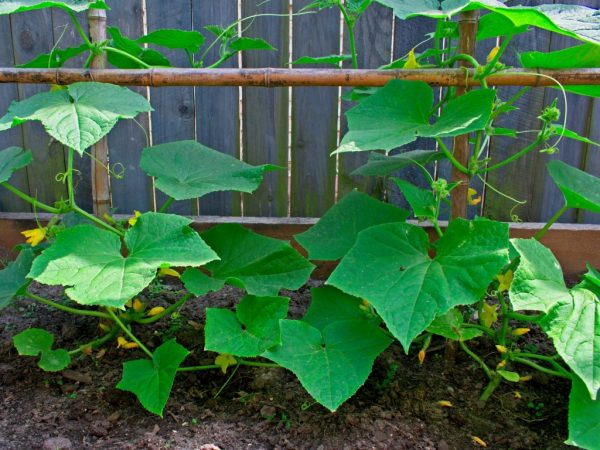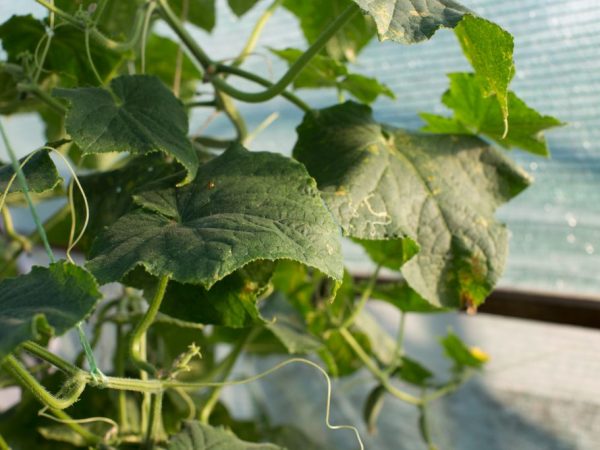Why cucumbers can grow poorly in a greenhouse
Very often, gardeners who prefer growing vegetables in greenhouses wonder why cucumbers grow poorly in a greenhouse? This is a fairly common problem that many face. In fact, there are several reasons why you can't grow tasty and crunchy cucumbers. All of them are associated with violation of the rules for caring for vegetables in a greenhouse.

Causes of poor growth of cucumbers in the greenhouse
Why is this happening
Often, novice summer residents have problems with growing cucumbers under a film. People who have been growing vegetables with their own hands for many years have learned to solve this problem through experience. As a rule, there are many reasons leading to the fact that the seeds do not germinate, and barren flowers are formed on the plant or the deformation of the fruit occurs. Moreover, they can occur at completely different stages of vegetable development - during the period of planting seeds and during their germination, the formation of seedlings, as well as during the growing season.
Among the main reasons that prevent cucumbers from growing, experienced vegetable growers call:
- poor soil preparation;
- violation of the temperature regime;
- violation of watering rules;
- improper chemical treatment;
- lack of nutrients;
- diseases and pests;
- improper pollination.
Are you sure that you adhered to all the rules, but the harvest still did not please you? Then carefully go through all the points below in order to understand what you miscalculated, and how you can correct the situation in the future.
Soil preparation
One of the most common reasons why cucumbers do not grow in a greenhouse is poorly prepared soil for cultivation. Please note that soil problems may not appear immediately, but only in the second or third year after the greenhouse was installed. This is due to the fact that in the spring, with the arrival of warm weather, various microorganisms begin to activate in the soil, which can cause the development of many diseases in a vegetable. If the soil is not changed, this can cause loss of yield as a result of the development of fungal diseases.
When preparing the soil for planting cucumbers, special attention should be paid to the following points:
- seedlings must be planted in the soil no earlier and no later than a month after the seedlings sprout - this rule is due to the fact that the rhizomes of young shoots are very vulnerable and need a fairly long adaptation period;
- if you decide to plant seeds in a greenhouse, do not forget to warm the ground thoroughly before that, otherwise they may rot without even hatching;
- despite the fact that you are planting seedlings in closed ground, you still need to wait for stable and warm weather, since with the arrival of spring it can be warm during the day, and at night it can get significantly colder up to sub-zero weather.
Temperature regime
When growing cucumbers in a greenhouse, do not forget that this is a very thermophilic vegetable. The most suitable mode for a plant is from 20 to 26 ° C (otherwise the seedlings grow poorly). If you do not keep track, and the temperature drops to 12 ° C, the seedlings will slowly ripen, and at a higher one, they will not be able to fertilize and will not create an ovary. In addition, when growing seedlings in a greenhouse, additional heating should be organized, since the sprouts are very sensitive and do not tolerate cold temperatures well.
Another equally important rule is compliance with the optimal water temperature when watering seedlings in greenhouse conditions. In no case should it be cold. The best option is if the water is at the same temperature as the soil.
Watering rules
In addition, it is important to properly organize the watering of the cucumbers. If the plant suffers from a lack of moisture, it will begin to turn yellow, wither and dry, and its fruits will be bitter. If you overflow water, then the seedlings can get sick, begin to rot and suffer from the fact that the soil is waterlogged.
First of all, the roots will suffer, which will die off and cannot take root. It is especially important not to overdo it with watering in the first days after the seeds are planted. The signal that you have flooded the plant will be a color change in the lower part of the stem. Do not water the cucumbers more than once every two days.
Chemical treatment

Plant feeding stimulates growth
The cucumber needs constant feeding. In the process of fertilization, the seedlings receive the necessary nutrients that help the cucumbers to grow, gain strength, ripen, and fight diseases. Thanks to a properly organized feeding process, gardeners increase the yield of this crop. In addition, breeders have bred such seedlings that simply do not grow without feeding, and does not yield a crop. Of course, it is very important to observe the timing and proportions of fertilization.
- First, you need to determine what kind of useful substances you want to use (organic or inorganic), and correctly calculate the dosage.
- Please note that once you have planted seedlings, you must feed them every week.
- It is important to respect the dosage. Otherwise, you can destroy the ovary and the whole plant. It is often worth applying fertilizers only if the seedlings have signs of insufficient nutrients.
- The next stage of feeding should be done when the first leaves appear on the seedlings. The second - no later than three weeks after the first procedure. The third time to fertilize is necessary before the flowering itself. The last time feeding is carried out fifteen days before the formation of fruits.
- Of course, improperly applied fertilizers can lead to the fact that cucumbers do not form ovaries, they will grow poorly and bear fruit.
Nutritional imbalance
Sometimes the reason that the seedlings do not grow in the greenhouse is the lack of nutrients, in particular nitrogen and potassium fertilizers in the soil. This is indicated by brown spots, small leaf size, and the formation of barren flowers. Seedlings may also suffer from a deficiency of manganese and phosphorus. In this case, the leaves of the cucumbers will be covered with marble colors.
What are the control measures? Operative feeding will help the gardener to solve this problem. For the procedure, it is necessary to take wood ash (at least 15 g), and dilute it in 10 liters of water. Instead of ash, you can take superphosphate. Please note that the solution should be infused within seven days. Fruits can also lack nutrients if, during planting, the beds were located very close. The most optimal distance for lashes is 20 cm. Then the bushes will not interfere with each other's strength.
Pests and diseases
It can be very difficult for an inexperienced gardener to understand that cucumbers do not grow well in greenhouse conditions because they are sick or have been attacked by pests.What to do in this case? In order to protect the seedlings from pests, it is necessary to treat them with special decoctions. The main ingredient in such infusions is garlic, which, due to its beneficial properties, easily relieves other plants from troubles with insects. No less effective in this case is a solution of potassium permanganate, mustard or ash.
Diseases, most often, arise due to violation of the rules of watering, temperature or humidity conditions. When pathogenic microbes start in the soil, which infect cucumbers with fungal diseases. Treatment is not very difficult, but only if you noticed in time that the seedlings are sick. In specialized stores today, a lot of all kinds of drugs are sold that will help you heal a diseased plant.
Pollination type
When choosing seeds for growing cucumbers on the store counter, most pay attention to the shape and taste of the fruit, and almost no one is interested in the instructions, which are necessarily placed on the packaging. The fact is that cucumbers are divided into two types: self-pollinated and those that are pollinated by insects.
Have you chosen self-pollinated cucumbers? Then you can plant them and no longer worry about anything - in any case, they will be able to set fruits on their own. In the event that you come across a variety that needs pollination, you must either attract insects to the greenhouse, or carry out this procedure yourself. For these purposes, as a rule, bee bait is prepared. Preparing a sweet solution is not difficult. Take 1 liter of water, add 1 tbsp. l. honey and 0.1 boric acid powder, and spray the solution over the garden beds.
Conclusion
For people who are not involved in gardening, it may seem that growing cucumbers in a greenhouse is very easy. However, this is only at first glance. Because the slightest changes in the rules of plant care can lead to the fact that the crop will be destroyed.
This vegetable crop requires timely and attentive care. Be sure to follow the rules described above, and then you will definitely be able to grow beautiful and tasty cucumbers. Have a great harvest!


